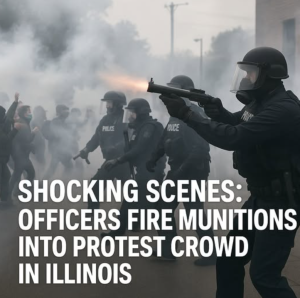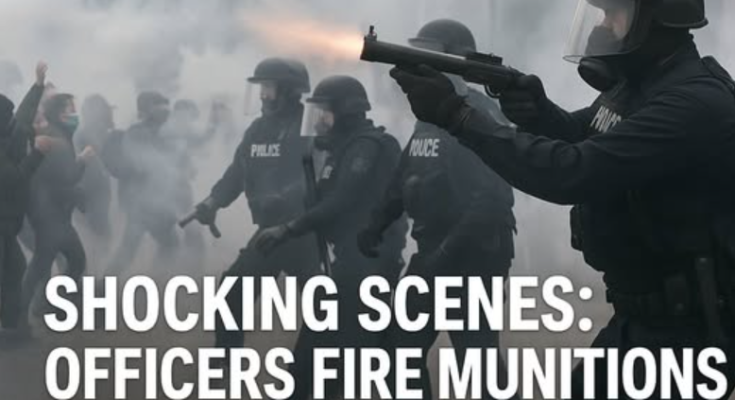
Tensions Boil Over in Illinois: Federal Agents Fire Munitions Into Protest Crowd
On September 19, 2025, a peaceful protest outside the U.S. Immigration and Customs Enforcement (ICE) facility in Broadview, Illinois, erupted into chaos as federal agents fired chemical munitions into a crowd of demonstrators. The incident, which involved tear gas and pepper ball projectiles, has sparked national outrage and renewed scrutiny of the Trump administration’s aggressive immigration enforcement tactics.
The Scene at Broadview
The Broadview ICE facility, located just west of Chicago, has long been a focal point for immigrant rights protests. On this particular Friday morning, dozens of demonstrators gathered to oppose a new ICE operation targeting traffic stops in predominantly Latino neighborhoods. Protesters carried American flags and signs reading “Hands off Chicago,” chanting slogans and singing songs in defiance of what they described as militarized immigration enforcement.
Among the crowd were local activists, religious leaders, and political figures, including Chicago City Council member Andre Vasquez and congressional candidate Kat Abughazaleh. The demonstration was peaceful until federal agents, clad in camouflage uniforms, began firing chemical agents from the roof of the facility and from behind barricades.
The Confrontation
According to eyewitness accounts and video footage, the agents deployed tear gas and pepper balls around 6 a.m., shouting “Your First Amendment rights are on the sidewalk” as they attempted to disperse the crowd. Kat Abughazaleh reported being pushed to the ground and struck in the legs by pepper balls. A visual journalist from the Chicago Sun-Times was also affected by the gas and had to leave the scene to recover.
The munitions created white clouds that wafted through the muggy air, irritating eyes and lungs and sending protesters scrambling. At least two demonstrators were arrested and taken inside the facility, where their whereabouts remained unknown hours later. Protesters claimed they had not seen the detained individuals since their removal, raising concerns about transparency and due process.
A History of Resistance
The Broadview facility has been the site of regular protests for years, including prayer vigils led by Catholic nuns and community gatherings aimed at drawing attention to immigration enforcement practices. The September 19 protest was particularly charged, coming just days after an ICE officer fatally shot Silverio Villegas Gonzalez, a man accused of evading arrest and dragging an officer with his vehicle. Authorities claimed the officer feared for his life, but activists questioned the use of lethal force.
Illinois Lt. Gov. Juliana Stratton, who spoke at the protest, condemned the federal response. “They want us to be afraid,” she said. “They want us to just kind of go into our little corners and not do anything. … We’re not going to let that happen”.
Political Fallout
The incident has intensified political tensions in Illinois and beyond. Critics argue that the Trump administration is using federal law enforcement to suppress dissent and intimidate immigrant communities. The use of chemical agents against peaceful protesters has drawn comparisons to past crackdowns on civil rights demonstrations and raised questions about the militarization of domestic law enforcement.
Kat Abughazaleh, who is running for Congress in Illinois’ 9th District, described the scene as a “war zone.” “We have signs and chants and songs, and they’re treating us like it’s a war zone,” she said. Her campaign has since called for an independent investigation into the incident and the broader ICE operation targeting traffic stops.
ICE’s New Operation
The protest was sparked by ICE’s announcement of a new enforcement initiative focused on traffic stops in immigrant-heavy neighborhoods. Critics say the operation is designed to instill fear and disrupt communities, particularly in Chicago’s suburbs. Unmarked vans have reportedly been used to detain individuals, and families have flocked to the Broadview facility seeking information about their loved ones.
Tania Ramos, 25, arrived at the facility hoping to reach her father, who had recently undergone back surgery and was detained during one of the traffic stops. Activists helped her communicate with him through the facility’s barriers, highlighting the emotional toll of the crackdown on families.
A Pattern of Escalation
This latest incident is part of a broader pattern of escalating enforcement under President Trump’s second term. The administration has rolled out a series of aggressive policies, including:
- Eliminating free legal counsel for unaccompanied minors.
- Empowering judges to deny asylum claims without hearings.
- Closing oversight offices that monitor detention facilities and law enforcement conduct.
These changes have drawn criticism from legal experts and human rights organizations, who argue that they undermine due process and violate constitutional protections.
Community Response
In response to the Broadview incident, activists have pledged to continue their resistance. Another protest was scheduled for 7 p.m. the same day, with organizers calling for a mass mobilization to demand accountability and transparency. Local leaders have vowed to support affected families and challenge the administration’s policies through legal and legislative channels.
Andre Vasquez, who witnessed the munitions being fired, emphasized the importance of solidarity. “We’re here to protect our communities,” he said. “We’re not going to let fear win.”
Legal and Ethical Questions
The use of chemical agents against peaceful protesters raises serious legal and ethical questions. While federal agencies claim the munitions were non-lethal and necessary to maintain order, civil liberties advocates argue that such tactics are disproportionate and violate the right to peaceful assembly.
The American Civil Liberties Union (ACLU) has called for a federal investigation into the incident, citing potential violations of the First and Fourth Amendments. Legal scholars have also questioned the deployment of camouflage-clad agents in civilian settings, warning that it blurs the line between military and law enforcement roles.
Looking Ahead
As the dust settles in Broadview, the nation is left grappling with the implications of the protest crackdown. Will there be accountability for the use of force? Will ICE’s new operation continue unchecked? And how will communities respond to the growing pressure from federal authorities?
The answers to these questions will shape the future of immigration policy and civil liberties in the United States. For now, the events in Illinois serve as a stark reminder of the tensions boiling over in America’s immigration debate—and the human cost of enforcement without empathy.

